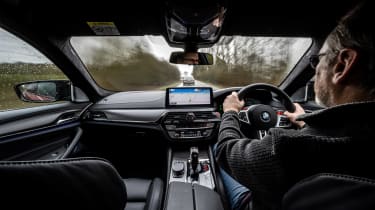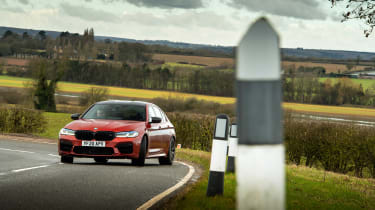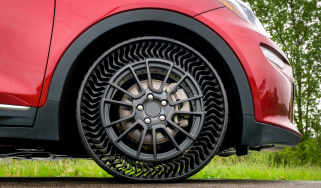Mercedes-AMG E63 S v BMW M5 Competition – supersaloon face-off
BMW and AMG make are the best in the business at creating truly captivating supersaloons, but who does it best now, before they both go hybrid?
Years ago, rumour had it that at least one car company referred to the button for turning off stability/traction control as ‘the journalist button’. I’ll wager that was true. Motoring journalists in search of exciting action shots in cars they don’t own will turn off systems designed to save them from crashing. Customers who’ve just paid tens of thousands for their car? Not so much.
What, then, to make of the facility to switch a 600bhp, two-ton saloon like the BMW M5 or Mercedes-AMG E63 from four-wheel drive to just rear-wheel drive? Some might wonder why this is even a thing, but there’s heritage and a bit of marketing behind it. The M5 and E63 can trace their bloodlines back over 30 years, to when their forerunners were smaller, lighter, less powerful and just rear-drive, because that worked brilliantly.
Power outputs have been on a relentless climb ever since, passing through the 400, 500 and now the 600bhp mark, but power is not the issue. It’s the fact that these engines are turbocharged, and turbocharged very effectively, delivering massive, near-instant torque from low revs. The M5 Competition and E63 S are four-wheel drive because the only way to get all that torque to the road is through all four tyres.
So, does the option to make these cars just rear-drive add to their enjoyment and appeal? Is a rear-drive M5 Competition churning out 553lb ft at 1800rpm even driveable in the wet? And what about an E63 S with an even more gargantuan 627lb ft from 2500rpm?
There’s a more fundamental question, of course: are the M5 and E63 enjoyable and rewarding as four-wheel-drive supersaloons? They must be compelling in four-wheel drive because that’s how they will be driven most of the time by the vast majority of owners. On a good road they need to feel engaging and rewarding as they deploy all that torque and power to all four wheels.
I confess that, even as a long-standing enthusiast of power oversteer, once I’d got a feel for the scale and mass of the M5 and E63 and felt their full performance, the prospect of going rear-drive in either made my mouth go dry. Despite weighing almost two tons, these fully loaded saloons can lunge to 62mph from rest in less than 3.5sec and forge on to 100mph in around 7.5sec, and, of course, part of the reason they weigh so much is because of the addition of a transfer box, front propshaft, front diff and front driveshafts.
Press the red start button and the M5 Competition bursts into life with an oddly indistinct V8 flourish. Previous turbocharged M5s have used the cabin speakers to generate a more traditional V8 rumble, but the Competition doesn’t seem fussed with that. Its note is lighter and more business-like with an eager edge. Pretty soon you appreciate that’s a characteristic that permeates the whole car.
Soon after you roll away you’re aware of the steering’s feedback and connection and also the high level of detail to the taut ride; the Competition has stiffer springs, a slightly lower ride height and revised geometry. Adding to the picture, the carbon-ceramic brakes are light and bite keenly from the top of the pedal. They’re part of the optional, £19,000 ‘Ultimate Pack’. Luxuriously equipped it may be, but the M5 Competition feels bright, keen to get going and show what it can do.
There’s no extra torque, but the Competition gets another 24bhp, taking it to 616bhp, and there’s very little delay between throttle demand and delivery despite it being turbocharged. This is especially true when you slot the bespoke M gearlever into manual to arrive at the apex already in the optimum gear for the corner.
At speed, the tautness of the suspension pays dividends, firm wheel control keeping the car poised and level over tricky tarmac, but there’s no disguising the weight; you can sense it over crests and when you dive into corners. In the dry, there’s a lot of grip from the fat Pirellis and the steering gives a bit of feedback so you can sense where the limit of grip is. You can be reassuringly accurate, too, as you need to be hustling a wide, two-ton saloon.
Despite the mass, the M5 feels agile and the speed it will carry, the grip its chassis finds and the amount of performance it can lay down is staggering. You can work the tyres to the limit of grip and then electronic stability control will gently intervene and hold the line, no matter how lead-footed you are. Through a corner the drivetrain will redistribute the torque to use as much as possible, or it will electronically manage it until there is enough grip, and when there is you fire from the corner and up the road like a cannonball.
It’s effective and impressive. But all the while you’re thinking about the elephant in the room: what’s it like in two-wheel drive? Before making the leap you can select MDM and 4WD Sport, which backs off the traction control a little, allowing the back end to slip a few degrees wide under full power. But if you think that’s anything like going just rear-drive, that you’re building a sense of the rear-drive M5, don’t kid yourself – it’s no more like it than bouncing off the diving board is like jumping from the 10m board.
We’re getting ahead of ourselves, though. The Mercedes-AMG E63 S has had over 600bhp for a while now, and delivers 74lb ft more than the M5 for a stupendous 627lb ft of torque, and all this from a slightly smaller, 4-litre V8 that carries the signature of the man who built it. Like the M5, in the last year the Mercedes has had a cosmetic nip and tuck, most obviously at the front, adopting a grille that looks borrowed from the AMG GT.
With its chamfered edges, the brawniest E-class looks less aggressive than the M5, and a little smaller. It feels different inside, too, like you’re sitting lower but also as if you’re in a less expensive car. Yes, there’s a massive, single screen incorporating the instruments and the multi-function centre console, and a wave of glossy carbonfibre trim stretching around the cabin, but the Mercedes doesn’t feel or look as well put together as the BMW. A colleague nailed it, saying that the M5 felt like a scaled-down 7-series but the E63 felt like an up-scaled C-class.
It’s not only the look of the E63 that has changed. A few years back when we group-tested the E63 S estate with the new RS6 and Panamera, the Mercedes sounded like a traditional AMG V8, with a glorious, thundering V8 soundtrack and overrun crackles and bangs. The fitment of exhaust GPFs on the latest version has diminished its character substantially and all-out it now sounds only a bit fruitier than the BMW.
It’s still a good place to be, though. Its seats might not be as complex and tailored-looking as the M5’s but they offer even better support, and although its steering lacks the levels of tactility and connection offered by the BMW, it is calmer, less distracted. Significantly, in terms of ride, these two supersaloons occupy different parts of the comfort spectrum.
The E63 S has air springs and its firmest setting, Race, is still more absorbent than Comfort in the M5. After the detailed, connected feel of the M5’s steering and ride, you initially feel like you’re driving a little ‘blind’ in the E63. Its four-wheel drive is less indulgent, too, less willing to give the rear axle as much leeway, even in its sportiest settings. It is very effective, though, deploying substantially more torque with less fuss through its Michelin PS 4 S tyres.
There is more audible V8 character, too. Yes, GPFs have absorbed much of its signature rumble but, ambling around at low revs, there’s still a lovely, rich brogue filtering through the bulkhead, character that you just don’t get with the BMW. Add in the more supple ride and loafing around is enjoyable and effortless, whereas the more alert M5 can feel like a dog pulling at the lead.
Other dynamic aspects of the E63 contrast with the M5, too. I often find the steering of AMGs a fraction too heavy, and frustratingly it’s one of the few characteristics that you can’t adjust in the set-up menu. But after a couple of stints at the wheel, I found myself preferring the E63’s weighting and ended up switching the steering on the M5 from Comfort to the weightier Sport, just to calm things down a little. And although the BMW’s optional carbon-ceramic brakes probably offer more endurance, especially if you’re tempted to venture onto a track, I prefer the softer, less abrupt step-in of the Mercedes’ iron discs.
So, is there any benefit, any reward for selecting just rear-drive in either of these cars? As journalists in other people’s expensive cars, we went there so you don’t have to. We tried them in two-wheel drive in the wet and the dry, though the first thing to say is that the hoops you have to go through to get the E63 into pure rear-drive suggest that Mercedes isn’t that keen on customers going there. In the M5 you can pre-program one of its steering wheel M buttons for rear-drive, with a second press to confirm that you know you’re selecting rear-drive and disabling all stability and traction control. The E63 is a right faff: turn off stability control, select manual and Race mode, pull both shift paddles back and, finally, pull the right paddle again to confirm. The dashboard then announces you are in Drift Mode.
Being totally honest, initially the change in the M5’s character on a wet road is a shock, like you’ve got margarine under the rear Pirellis rather than water. The ready torque of the M5’s V8 kicks its rear sideways with such ease that if traction control was active, the warning light would be a consumable because it would be busier than a one-legged man at an arse-kicking competition. The tail of the M5 either swings wide quickly or stays straight with the rear wheels juddering as the active rear diff – the last line of defence – finds and exploits whatever traction there is.
Build up some speed, get up to a B-road pace, and the back end of the BMW is more predictable. After a few miles you’re getting a feel for where, when and how traction will be breached and the tail might move. You need to be confident and accurate with the opposite lock, and to make it all smooth and flowing you need to ride out slides on a steady throttle if you can. If you are up for this challenge, it’s satisfying when you get it just so. Pick your moments, develop throttle-sensitivity and learn what gets the back of the M5 just on the edge – and now you have adjustability and interaction on a whole new level. It’s fascinating and utterly absorbing. A wet trackday would be a good training exercise, to find out how the car responds and how to react to smooth out the winding on and off of opposite lock.
The E63 is the same but different. It slips its tail wide more smoothly at low speed in the wet, more consistently and predictably. In the right place you can balance it sweetly for big opposite-lock yardage, which is both fun and satisfying and pleasingly relaxed, too. There’s some odd sort of delay at higher speeds, though. Into the same corner as the BMW, hit the throttle at the same point and it feels like the rear grip is going to hold but a moment later it lets go and you have to react with a stab of opposite lock. It’s the same in the dry, too, which is a bit frustrating.
Meanwhile, with dry asphalt under its wheels, the M5 just gets better, that firmer Competition chassis coming into its own. Knowing how it felt from the off, this is expected, and while the M5 doesn’t exactly shrink around you, it feels the lighter, more agile and more exciting car. In the right circumstances you can still play with the odd powerslide, too, though just as in the wet, all aids are off so you need to know what you’re about. This E63 rides better and has more composure than the estate we drove a year ago but there’s no question that the BMW is the sharper tool for dissecting a road, offering more steering feedback and precision, more connection with the road. That said, the E63 still has the grip and pace to peg the M5.
Is the rear-drive-only option a benefit or a liability? Is it a novelty that most customers never use? I’m sure many M5s and E63s will never know rear-drive only, but it’s not a wasted feature because those customers with the confidence and skill to use it will appreciate it hugely. The M5 is as sporty as anything in this class, but up at this scale and mass there’s only so much performance you can use, only so much satisfaction from ripping through corners fully hooked up, driving hard. The ability to get more involved at lower speeds, to be more influential over the car’s balance and attitude, more responsible for its progress, is so rewarding, and that’s why the option to go rear-drive is most definitely a good thing.
Specs
| BMW M5 Competition | Mercedes-AMG E63 S 4Matic+ | |
| Engine | V8, 4395cc, twin-turbo | V8, 3982cc, twin-turbo |
| Power | 616bhp @ 6000rpm | 604bhp @ 5750-6500rpm |
| Torque | 553lb ft @ 1800-5860rpm | 627lb ft @ 2500-4500rpm |
| Weight | 1895kg | 1935kg |
| Power-to-weight | 330bhp/ton | 317bhp/ton |
| 0-62mph | 3.3sec | 3.4sec |
| Top speed | 155mph (limited) | 186mph (limited) |
| Basic price | £102,325 | £96,565 |
| evo rating | 4.5 | 4.5 |












